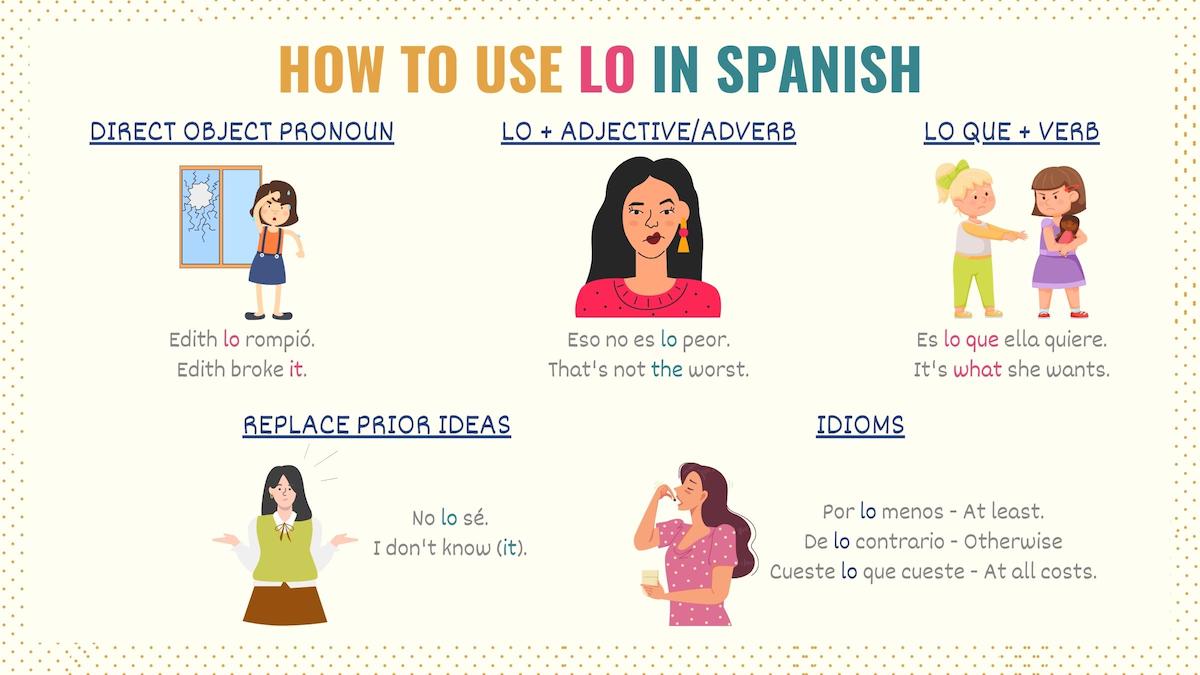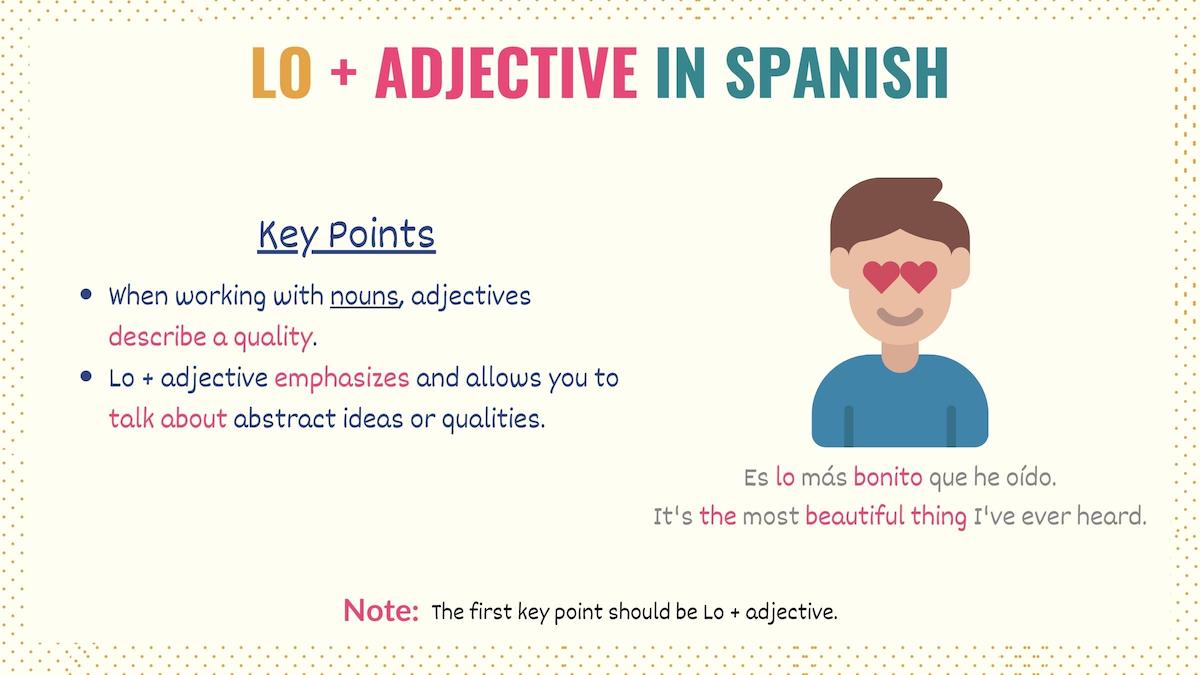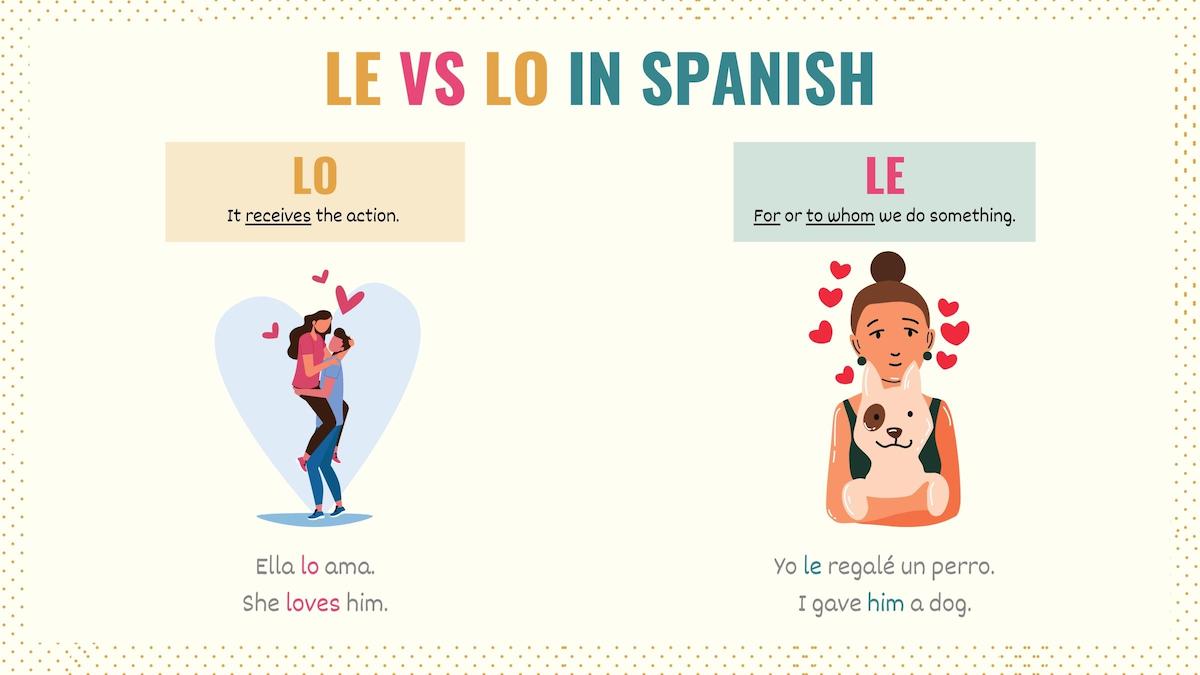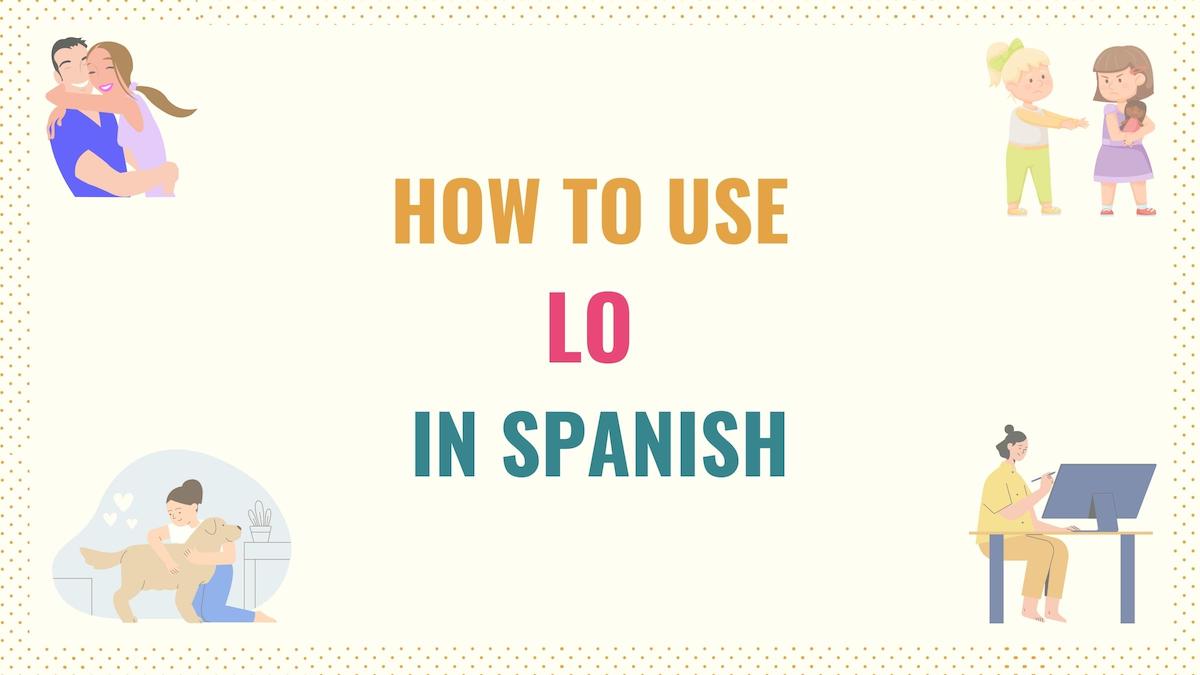The word lo in Spanish is commonly used in daily conversations –lo siento, no lo vi, lo que dices. Sounds familiar? However, this word can be confusing since it has multiple meanings and applications. So, in this guide, you’ll learn how and when to use lo in Spanish.
Here is an overview of what we’ll cover:
To make things easier, I’ve included common sentences with lo that can help you understand this word.
What Is Lo in Spanish
In Spanish, lo is an invariable word. Simply put, it has a single form and has no gender or plural form. Depending on the elements of the sentence, lo can be a pronoun or a neuter article:
No lo puedo hacer.
I can’t do it.
Lo que quiero es que me ayudes.
What I want is for you to help me.
Lo bueno es que no pasó nada.
The good thing is that nothing happened.
Notice that since it cannot provide information about the number or gender of a noun, lo is never followed by nouns.
The elements it works with define the type of word lo is in a sentence. In the sections below, we’ll learn the different structures we must use to apply this term correctly.
Take Note: There are no neuter nouns in Spanish. In fact, one of the main characteristics of Spanish nouns is that they have gender and number. As a result, the adjectives or determiners you use (such as articles) must also convey this information.
How & When to Use Lo in Spanish
The graphic below shows the most common uses of lo in Spanish:

As you can see, the meaning and translation of lo will vary depending on the application. Let’s dive into each use so you get familiar with them.
1. Direct object pronoun lo
Lo works as a Spanish direct object pronoun when replacing a masculine singular noun. This noun receives the action of the verb. In this case, lo is the equivalent of ‘him’ or ‘it’.
Ella lo rompió.
She broke it.
Lo perdoné porque lo amo.
I forgive him because I love him.
¿Ya conoces a Juan? Yo lo conocí ayer.
Have you met Juan? I met him yesterday.
El pastel está destruido. No puedo arreglarlo.
The cake is destroyed. I can’t fix it.
Take Note: Direct objects can be people, animals, or things. But, to replace them, people must know or understand what you’re talking about.
2. Neuter article lo
The neuter article lo is used with adjectives or adverbs to emphasize and talk about a quality or abstract idea. This Spanish neuter article can be translated as ‘the’ or ‘as’. Here are some examples:
Lo + [adjective / adverb]
Eso no es lo peor.
That’s not the worst.
Ven lo más rápido que puedas.
Come here as fast as you can.
Lo importante es que estés bien.
The important thing is that you’re okay.
Eres lo mejor que me ha pasado.
You’re the best thing that ever happened to me.
Check example #2. The neuter article lo can be used to form comparatives in Spanish. Also, you can combine this word with possessives and other types of adjectives:
Lo mío es aprender idiomas.
My thing is learning languages.
No se le quita lo arrugado.
The wrinkles don’t go away.
Take Note: In Spanish grammar, lo + adjective is the formula to transform an adjective into a noun. We do this to emphasize qualities or talk about abstract ideas. Since we’re emphasizing, lo may not always have a direct translation into English.

3. Relative expressions: lo que
Lo que refers to implicit statements, concepts, or ideas previously discussed. So, in this application, the pronoun lo means ‘what’ or ‘which’. A conjugated verb must follow this structure:
Lo que + [conjugated verb]
Eso no fue lo que dije.
That’s not what I said.
Lo que Jack quiere decir es que…
What Jack means to say is that…
Tranquila, no es lo que parece.
Easy, it’s not what it looks like.
Lo que significa que estamos en problemas.
Which means that we’re in trouble.
Take Note: Relative pronouns in Spanish allow you to combine two sentences together and avoid repetition. In short, they’re crucial for clear communication.
4. Replaced concepts previously mentioned
As a pronoun, lo allows you to replace implicit topics or ideas (that were previously mentioned). For instance, we often use this word to respond to questions with the verb ser.
Lo + [conjugated verb]
No lo sé.
I don’t know.
Lo sentimos mucho.
We’re very sorry.
| Spanish | English |
|---|---|
| Persona 1: Hija, ¿eres feliz? | Person 1: Are you happy, daughter? |
| Persona 2: Sí, papá lo soy. | Person 2: Yes, dad, I am. |
The pronoun lo may not have a direct English translation in this application.
You can also use the structure lo + de + noun to talk about an implicit situation or event:
¿Supiste lo de Laura?
Did you hear about Laura?
¿Qué pasó con lo del proyecto?
What’s going on with the project?
5. Idiomatic expressions with ‘lo’
Finally, this word is also used in many expressions and idioms. Here is a list of some of these idiomatic expressions:
- A lo ancho: Across / Wide
- A lo hecho, pecho: What is done is done
- A lo mejor: Maybe
- A lo largo de: Over / Thought
- A lo que vinimos: Get to the point
- A lo tonto: Awkwardly / Stupidly
- Antes de lo esperado: Sooner than expected
- Cortar por lo sano: Make a clean break
- Cosechar lo que siembras: Reap what you saw
- Cuando menos lo esperes: When you least expect it
- Cueste lo que cueste: Whatever it costs / At all costs
- De lo contrario: Otherwise
- Dentro de lo que cabe: All things considered / As far as can be expected
- El tiempo todo lo cura: Time heals all wounds
- En lo más mínimo: In the slightest
- Por lo menos: At least
Spanish Grammar: Lo vs Le in Spanish
When it comes to Spanish pronouns, lo and le are often confused because they both replace singular masculine nouns. However, these pronouns are far from being interchangeable.
The direct object pronoun lo replaces a noun that receives the action of the verb. On the other hand, le replaces an indirect object or the person or thing to or for whom we do something:
Ella no lo quebró.
She didn’t break it.
Nosotros le compramos un celular.
We bought him a phone.

Key Points
Since it has multiple applications, the word lo can confuse many Spanish learners. Here are some key points you should keep in mind:
- Lo is an invariable word that doesn’t have gender or number. As a result, it cannot be followed by nouns.
- It means ‘him’ or ‘it’ when replacing the direct object of a sentence (the person or thing that receives the action).
- When combined with an adjective or adverb, lo is a neuter article that emphasizes qualities or refers to abstract concepts or ideas. It means ‘the’.
- As a relative pronoun, lo que means ‘what’ or ‘which’. It’s used to join sentences together and replace a statement or concept that was previously mentioned.
Next Steps to Master Lo
Now that you’ve got familiar with this word, there are a few steps you can take to master it. Since many Spanish learners confuse le vs lo, you should take the time to understand how and when to use direct and indirect object pronouns.
As established before, a neuter article works with adjectives. However, it can never work with nouns. So, check this guide to definite articles to understand how to use el and la instead of ‘lo’.
Finally, understanding Spanish nouns can increase your vocabulary and prevent you from making common mistakes, such as assuming that lo works with a masculine noun.
Download the How to Use Lo in Spanish PDF
The word lo in Spanish can help you communicate more naturally. Since this word and its structures can be challenging for many learners, I’ve created this summary PDF so you can check anytime you want how and when to use this term.



